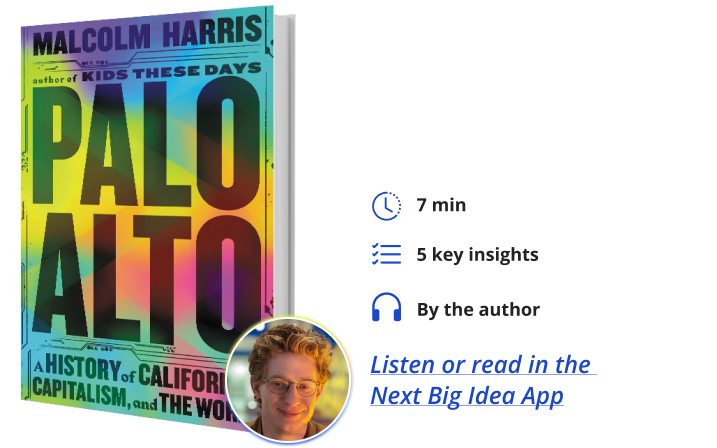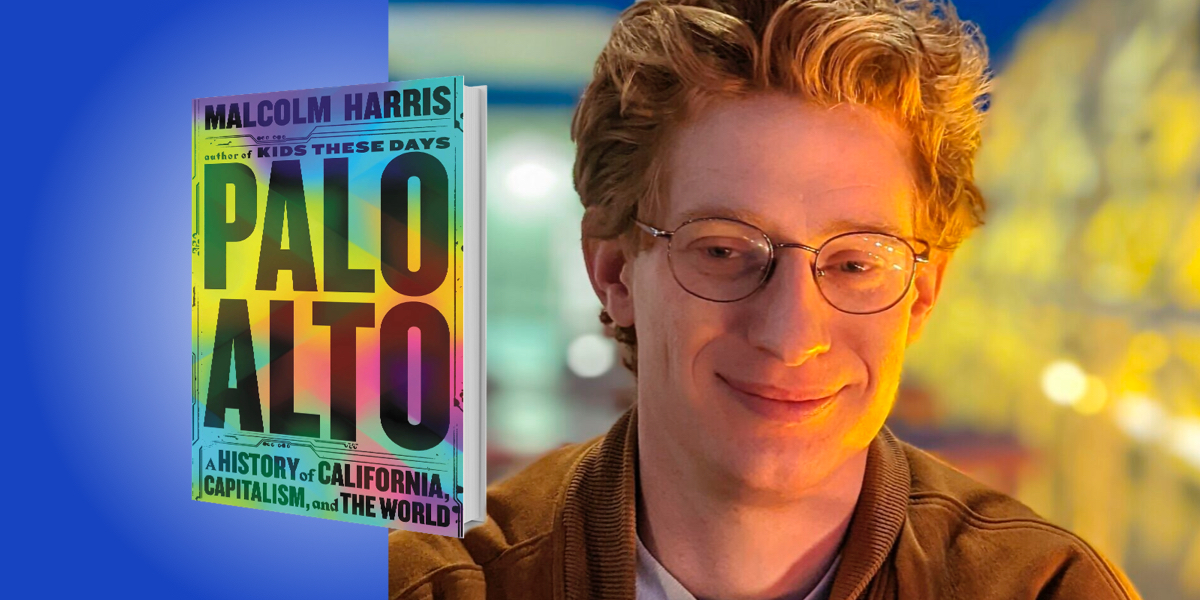Malcolm Harris is a journalist and editor at The New Inquiry.
Below, Malcolm shares 5 key insights from his new book, Palo Alto: A History of California, Capitalism, and the World. Listen to the audio version—read by Malcolm himself—in the Next Big Idea App.

1. Think dialectically.
We have to start by acknowledging that things aren’t always as they appear, that they are composed of contradictions. We know that impersonal forces driving history are more important than the particular personalities that characterize them, and yet we can only access these forces through people and their actions.
How do we begin to understand a world where people make their own history, but not under circumstances of their own choosing? The answer is to think dialectically, using the science of internal relations to investigate how real people make something out of what’s been made of them. This is my approach to the infinitely complex subject of 170 years of history in Palo Alto.
2. Analyze.
In step one, we look for connections in the present, and the structure of the whole in its parts. The investigation began by connecting the extraordinarily high rate of youth suicide in Palo Alto during the 21st century, with the extraordinarily high rate of capital accumulation in Silicon Valley during the same time.
“How do we begin to understand a world where people make their own history, but not under circumstances of their own choosing?”
Why was the self-declared greatest engine of wealth production in human history simultaneously producing an environment in which the children of that wealth, the ones being prepared to carry that accumulated wealth into the future and continue the regional industry’s enormous success—not to mention the future of the American project— choosing instead to destroy themselves? The dance of the dialectic begins with this kind of question.
3. Historicize.
In the second step, we look for the preconditions of this contradiction in the past. Palo Alto was a spinoff of the railroad, named for a big tree alongside the tracks. One of the people credited for that railroad was robber-baron named Leland Stanford. He created Palo Alto as a place where he and his family could escape from angry workers who blamed him for their declining wages.
He built the town as a cutting-edge laboratory, first to make the fastest trotting horses, then to make skilled engineers for America’s new high-tech industries: mining, agriculture, and radio. At the same time, California’s world-beating scientists pioneered new ways of driving down labor costs, whether eugenically breeding humans for high-IQs or organizing vigilante gangs to beat workers with sticks and shoot them down with pistols. This grinding contradiction between limitless growth and brutal repression sparks Silicon Valley into being.
4. Visionize.
In step three, we project the major contradictions forward through history, into the present and future. Here is where the bulk of the work goes down, as we drag the Palo Alto problematics through the 20th century and into the 21st. As class conflict developed between earth’s new class of capitalists and workers everywhere on whom they rely, the tension between growth and repression yielded conflict at the global scale.
In Palo Alto, growth raced ahead, developing the military tools necessary to subdue not just the fascist menace of Nazism, but the anti-colonial movements which caught fire in the wake of allied victory in WWII. America built its unipolar postwar economy on a bed of nails: nuclear missiles. At the core of each of those missiles was a new technology: silicon chips.
“The tension between growth and repression yielded conflict at the global scale.”
With friendly production enclaves secured by the atomic umbrella, capitalist America integrated the world’s population into a single system, intertwining, for example, Silicon Valley’s most valuable company with ostensibly socialist China. And yet, the contradictions have endured. The capitalist tendency to exhaust both every natural resource and the shared body of labor has only accelerated, and the biosphere has plunged into crisis. The culmination of Palo Alto at a global scale has meant catastrophe at the same level, and to the degree the future looks certain, it’s a disaster.
5. Organize.
In the final step, we look back for proximate preconditions of the future in the present we have, and use them to orient ourselves politically. Silicon Valley techno-lords love to present themselves as the solution to our various acute crises. We know, however, from our previous steps that their growth-and-profit-based model is inextricable from and, in fact, identical to the exhausting system that has brought us beyond the edge into an actually occurring planetary emergency.
The Palo Alto System which grew from the impersonal and external body of Leland Stanford cannot be a solution to itself. It can only provide the preconditions for the further accumulation of profit, which always exists in equal and opposite proportion to misery and destruction.
To find the preconditions for an emergent sustainable social metabolism for humanity on earth, we need to look before and beyond Palo Alto. This process could begin with the return of the Stanford lands to the Muwekma Ohlone, whose ancestral stewardship of the land and current tribal existence Stanford acknowledges. If, seized by larger historical forces, capitalist decisionmakers like those in Palo Alto find themselves unable to cede land to those who are capable of caring for it responsibly—which is likely the case—they force humanity into a struggle that will surely end with either the revolutionary overthrow of near 200 years of planetary capitalism or the mutual ruin of the contending classes.
To listen to the audio version read by author Malcolm Harris, download the Next Big Idea App today:





























